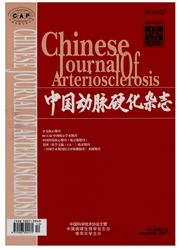

 中文摘要:
中文摘要:
目的探讨冠心病患者血红素加氧酶1启动子区(GT)n重复序列多态性与冠心病的相关性及其对血清胆红素水平的影响。方法采用聚合酶链反应一非变性聚丙烯酰胺凝胶电泳法检测337例冠心病患者和240例健康对照者血红素加氧酶1启动子区(GT)n重复序列多态性,同时测定血清胆红素水平。结果冠心病组与对照组LL基因型及L等位基因频率分布差异显著(P〈0.05);L等住基因频率在冠心病不同病变程度之间分布差异显著(P〈0.05),且LL基因型频率在多支血管病变组较单支和双支血管病变组高(P〈0.05);LL基因型者胆红素水平较SS基因型者明显下降(P〈0.001)。结论血红素加氧酶1启动子区(GT)n重复序列多态性与冠心病的发生发展及冠状动脉狭窄程度有关,L等位基因是冠心病的一个危险因素,可能与该基因多态性所致血清胆红素水平降低有关。
 英文摘要:
英文摘要:
Ahn To investigate the association between coronary heart disease ( CHD ) and heme oxygenase-1 (HO-1 ) promoter region {GT)n repeated sequence polymorphism and the influence of the level of serum bilirubin. Methods The polymorphism of HO-1 gene in 337 CHD patients and 240 health controls was analyzed by polymerase chain reaction-native polyacrylamide gel electrophoresis, and the level of serum bilirubin of each patient at the same time was detected. Results The HO-1 genotypes were classified into three groups: LL, LS and SS. The LL genotypic frequency and L allele frequency in CHD patients was significantly higher than control group ( P 〈 0.05) ; the L allele frequency had different distribution in single, double and muhivessel disease ( P 〈 0.05 ) , and the LL genotypic frequency of multivessel disease patients was higher than that of single and double vessel disease patients (P 〈 0.05 ) ; bilirubin level of LL genotype patients was significantly lower than that of SS genotype patients (P 〈 0. 001 ). Conclusions The polymorphism of HO-1 promoter region ( GT) n repeated sequence plays an important role in CHD pathobiology process, L allele frequency is a risk factor of CHD, which maybe correlate with its potential ability to decrease the serum bilirubin.
 同期刊论文项目
同期刊论文项目
 同项目期刊论文
同项目期刊论文
 期刊信息
期刊信息
